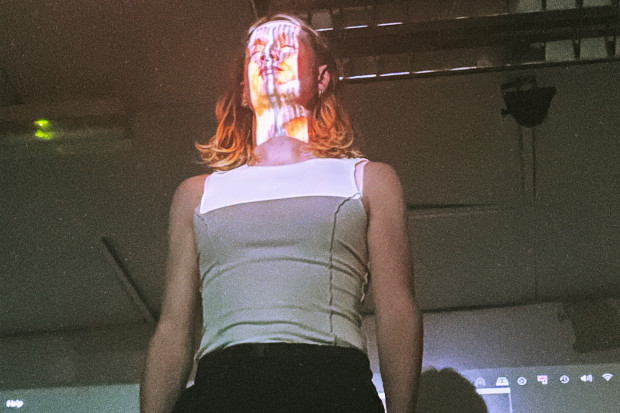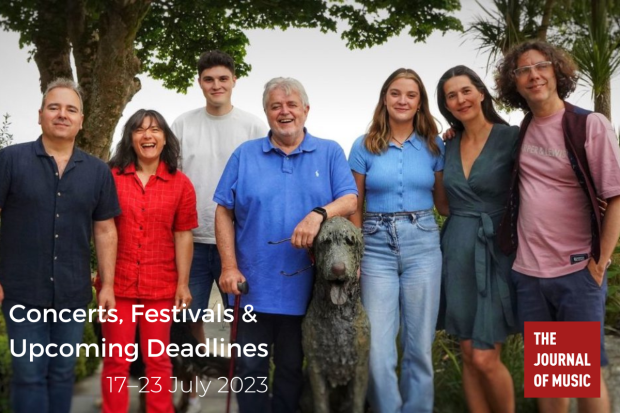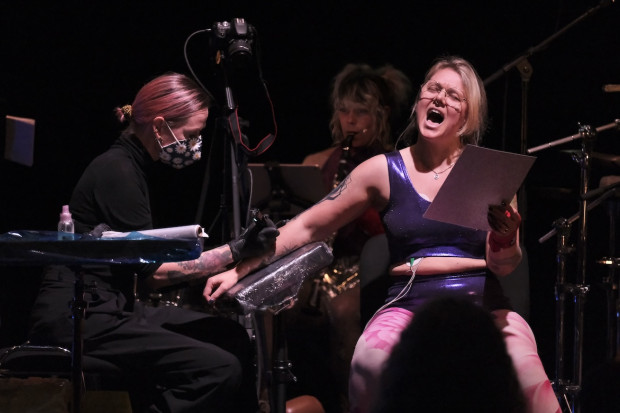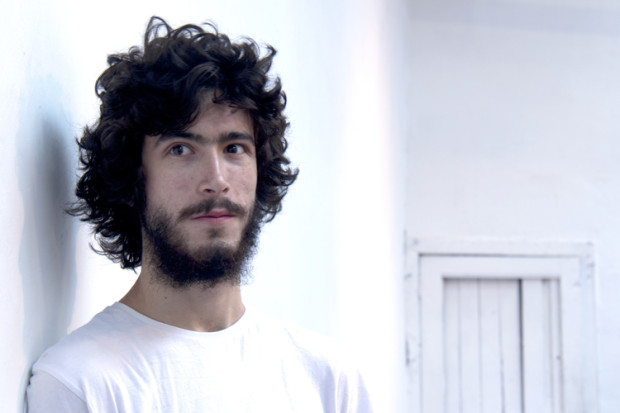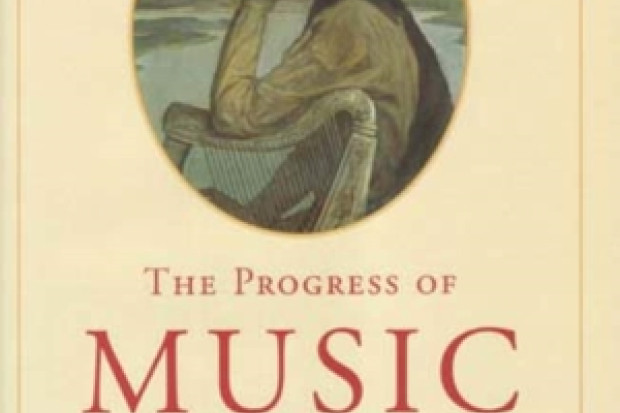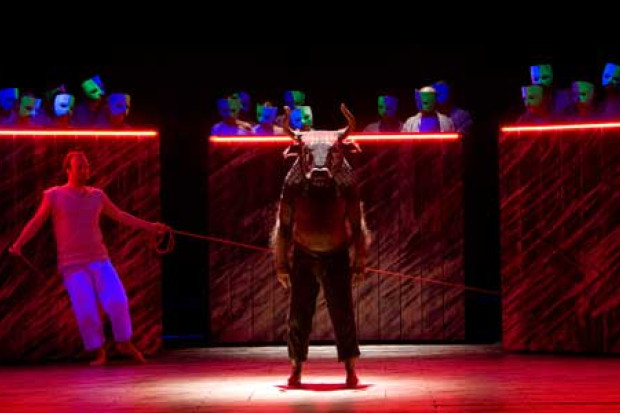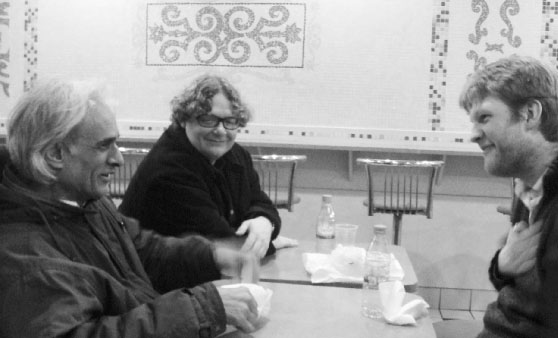
Rohan de Saram, Marc Sabat and Garrett Sholdice in Iskanders, Dame Street, Dublin after the performance of Feldman’s Trio at the Printing House Festival of New Music (Photo: Benedict Schlepper-Connolly)
Live Reviews: Life After Feldman
We could go directly to the music played at the 2007 Printing House Festival of New Music, noting in passing that it is called ‘Life after Feldman’. Feldman has been dead for twenty years now; this is mostly music written since his death; so on with the music… But maybe we should take the title a little more seriously: are we going to be dealing with a selection of music by the man himself or that links back to him in some way?
But is invoking life after Feldman such a simple matter? Some artists can be seen as links in a chain. They connect with the past and offer possible directions into the future. If Feldman were an artist of this type, life after him would be unproblematic. As a person, he had his fascinations. He was a great improvisatory speaker. His occasional writings flash with seemingly casual insights into music, painting, the creative process, living. He was large, loud, wilful, funny, touchy, selfish, perceptive… To add to the fascination, this brash character wrote some music of extraordinary calm. Feldman also renounced gadgetry, electronics, the drama of the self, and the sequential logic of European modernism. Most of his music is written for formations – solo piano, string quartet, piano quintet, cello and orchestra – that were current a hundred years ago. Are we then talking of an almost comfortable presence? But the more you open yourself up to the Feldman experience, the less cosy it is. Feldman does a lot of taking away, and the act of removing the expected, sometimes at extraordinary length, becomes a challenge to our concentration, our patience, our understanding, our sense of drama and structure, our memory. This is how time becomes his canvas and how his deep involvement with contemporary painting and painters begins to make sense.
All of which means that to invoke Feldman is to invite listeners to bring with them some awareness of the questions that Feldman asks. Festivals often open with blare or drama. Here the festival opener was Feldman’s own The King of Denmark, a thing of touches, hummings, sonic stepping-stones – appropriately enough perhaps, given that intent listening to small-scale effects was what was demanded by much of the music to come. In the first concert of the festival, the RIAM Percussion Ensemble offered a muted but attractive selection of pieces. While Feldman would sometimes lay minutely varying brush-strokes on the canvas one after another, sometimes for hours on end, it is also possible to operate in the Feldman mode by isolating and scrutinising a tiny number of strokes. Thus, Larry Polansky’s Haiku & Frengelmusic (from Tetherball) came down to micro-gestures at times, with Jo Kondo’s Pendulums a more controlled play with repetition. Clive Wilkinson – who also invokes haiku – drifted towards gentleness and simplicity in his three pieces: Pool, No Obstacle to Sleep and Bright Moon. Two Irish contributions, both premiered at the festival, could be seen as coming under the sign of Feldman: Donal Sarsfield’s Amarimba Grey succumbed a little too much to the ‘overcastness’ it sought to evoke; Benedict Schlepper-Connolly’s Ocean, with its mantra-like repetition of the title (sung by mezzo-soprano Michelle O’Rourke), did not quite carry off its attempt at poetic stasis. Judgement must be tentative in this area: after all, only total devotees would say that Feldman himself never strayed across the line into banality or tedium as he followed his intuitions; there is an inherent risk when working in this fashion. Aengus Ó Maoláin’s clunge/elegance, a festival commission, appeared to bypass Feldman entirely as it banished anxious whisperings in favour of full-voiced rhythmic extraversion. It was good to see a young percussion ensemble willing and able to tackle the full range of music on offer.
Pianist Aki Takahashi has had a long association with Feldman’s music. In her mid-afternoon concert she offered beautifully detailed performances of a selection of mostly delicate solo piano works by Michael Byron, Barbara Monk Feldman, Walter Zimmermann (this one involving tinklings on a child’s piano as well), Bunita Marcus and Christian Wolff – the piano equivalent perhaps of what we had heard earlier for percussion. In To Weave, a Meditation, the musical language of James Tenney (himself a quietly influential composer) overlapped with Feldman’s in some respects but was more deliberate in construction. Tenney’s use of algorithms in determining pitch choices and connections – he spoke of ‘crystal growth’ – is an influence on Marc Sabat’s practice in his reminded of charlemagne palestine, involving (among other matters detailed in his programme note) interaction between just intonation relationships and fixed pitch instruments. For me, on first listening, this was a somewhat unrewarding experience, perhaps because its impressive internal logic escaped me. For this work, Takahashi was joined by the composer on violin and by Rohan de Saram (formerly a member of the Arditti Quartet) on cello.
In the main Saturday evening concert, the ConTempo Quartet gave us the Irish premiere of Garrett Sholdice’s String Quartet (which failed to engage this listener, despite the care that audibly went into its construction), Ian Wilson’s wispily melancholic String Quartet #6 (‘in fretto, in vento’) and John Cage’s Four. Whatever its virtues, Christopher Fox’s 1-2-3, with its emphatic, almost cartoonish rhythms seems alien to the worlds both of Ligeti, to whom it is dedicated, and of Feldman (though Fox’s essay on ‘Our Great Dead Contemporary’ (JMI, Nov–Dec 07) is well worth reading). There was a touch of Reich to the motif at the heart of Donnacha Dennehy’s festival-commissioned Pushpulling, but dynamised, if not pulverised, by the repeated assaults it had to undergo. Many were enthralled by Jennifer Walshe’s minard/nithscale, but I was not convinced that the sustained tongue-clackings took the music anywhere more interesting than the instrumental and other effects – a darkened room, cardboard used to distort string sounds, boomboxes and so on. (Having witnessed the wonders that emerge from the mouth and throat of Phil Minton, I have no prejudice against mouth-music per se.)
In a change of musical direction, the late-night concert – a rare and perhaps unique event – was for solo acoustic bass. Ronan Guilfoyle’s manifold activities need not be invoked here. On the night, he showed himself in full control of his musical territory – marked by intricate pattern-making, a clear sense of direction, and a fondness for quirky endings. I would have welcomed a little more elasticity of approach – Ornette Coleman sounded too like Guilfoyle, for example – but, with three improvisations to electronic backing, the concert was well paced and drew an enthusiastic response.
I was sorry to miss the Seán Clancy festival commission and the thirteen one-minute pieces by members of the Young Composers’ Collective that formed part of the Dublin Guitar Quartet’s Sunday lunch-time concert. Later in the afternoon, Paul G. Smyth played Simon O’Connor’s Ovum, an impressive exercise in contrast. A ferociously sustained wall of sound in the first section gives way to a second that is all space and quiet, to be followed by a return to ferocity: an alarming bracketing of a Feldmanesque gesture perhaps? Ensemble Imp then played Brian Ledwidge Flynn’s Combination Lock. A prolonged exercise in atmosphere, this did not do enough, it seemed to me, to avoid lapsing into pleasant background music. There were many in the audience who were of a more positive opinion, however.
To cap the festival, we were treated to a deeply involving, extremely slow unfolding of Trio, one of Feldman’s late works. This is, typically, both a piece of music and a testing of what music is. It is also both a testing and a delighting experience for the listener. A festival that had already proved itself was totally justified by the fascinating musical journey offered by Aki Takahashi, Rohan de Saram and Marc Sabat.
Published on 1 March 2008
Barra Ó Séaghdha is a writer on cultural politics, literature and music.










